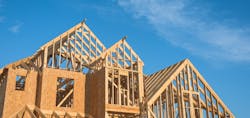Residential Construction Increased 20% in Outlying Counties in 2020
Single-family construction boomed in the suburbs, exurbs, and rural communities in 2020—a direct result of the COVID-19 pandemic, according to the National Association of Home Builders’ Home Building Geography Index (HBGI). To meet homebuyer demand for lower density, more affordable housing, home builders ramped up construction in the second half of 2020. Small metro areas, suburbs, and exurbs of both small and large metro areas experienced the greatest growth, but outlying counties of smaller metro areas saw a 20.7% growth rate. Large metro core areas experienced the slowest growth rate at 9.1%.
Lower-density markets gained 1 percentage point in their combined market share of home building over 2020, ending with 48.6% at the end of the fourth quarter. This represented an acceleration of an existing trend due to affordability conditions.
While all regional submarkets showed growth in the fourth quarter, the submarkets of large metro areas (core and suburban counties, and exurbs) lost traction as evidenced in their declining market shares. These areas saw their share of single-family home building decline from 52.4% to 51.4%, a statistically significant decline.
